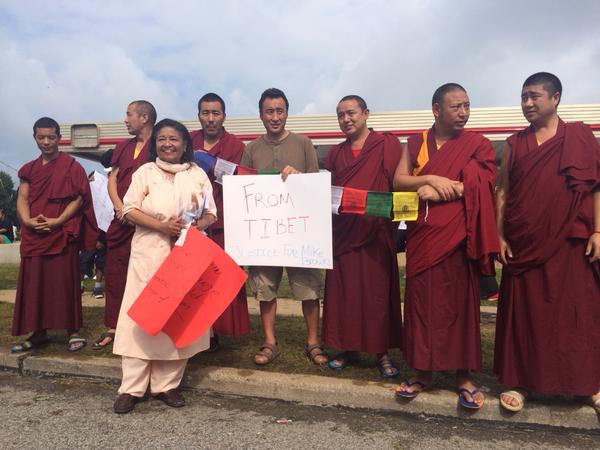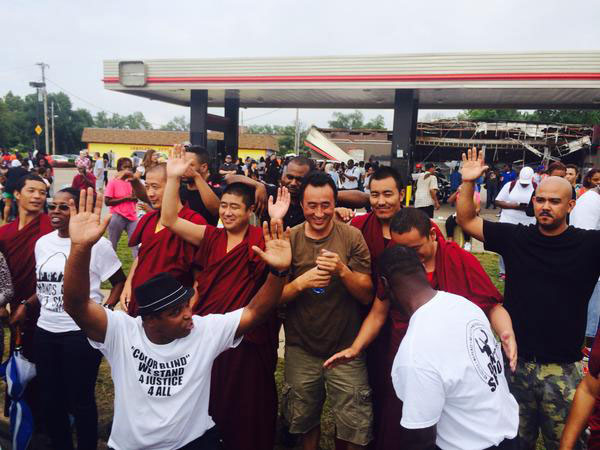
Tensions continued to escalate in Ferguson, Missouri over the death of 18-year-old Michael Brown, an unarmed black teenager shot and killed by a white police officer, Darren Wilson, on August 9. His death set off days of protests and a heavy-handed, militarized police response that has sparked national outrage.
But Ferguson residents got a pleasant surprise on Sunday: A visit from a group of Tibetan Buddhist monks.
“Ferguson was a very heated issue in our backyard,” explained Patty Maher, who is hosting the monks during their stay in St. Louis. “Sunday was their day off. . . . We didn’t know what to expect, but they gladly went. And as you saw, their presence was profound.”
The six monks, from Drepung Gomang Monastery in southwest India, arrived in St. Louis on Saturday as part of the Sacred Tibetan Arts tour, which their monastery puts on every year. They will spend the next ten months traveling cross-country to give lectures, create Tibetan sand paintings (mandalas) and perform traditional ceremonies.
According to the monastery’s website, the tour aims to increase awareness of Tibetan culture, raise funds for the monastery’s upkeep, and “make a contribution to world healing and peace.” This is the tour’s third year visiting St. Louis, though Maher says different monks come each time.
Geshe Tsewang Thinley is one of the monks visiting the US for the first time with this year’s tour. He grew up in a Tibetan refugee community in India, where many Tibetans fled after the Chinese invasion in 1950 and a failed uprising against Chinese rule in 1959.
“In Tibet, you know, many times it happens like this. Everywhere, every month, they have the problem in Tibet, same, the police shooting like this,” Geshe Thinley explained, speaking of Chinese forces’ frequent use of live rounds against nonviolent protesters.
Just four days after Michael Brown’s death, Radio Free Asia reported that Chinese police wounded almost a dozen Tibetans when they opened fire on a protest in Kardze. Since then, five of the protesters have reportedly died of their injuries.

Geshe Thinley, the other monks, and their assistant Tseltem Gyatso went with Maher to Ferguson for a couple of hours on Sunday. In front of the Quick Trip gas station destroyed the week before, they shook hands and posed for pictures during a festive daytime protest.
According to Amy K. Nelson, a contributing editor at Animal New York who was at the scene, a local woman made the monks a sign that read “From Tibet Justice For Mike Brown.” Others showed the monks the “hands up, don’t shoot” gesture that has become a hallmark of protests in Ferguson and beyond.
“People said that Michael Brown had, before the shooting there, hands up, but police also shoot him. This is wrong. So all people said, like this,” Geshe Thinley explained, placing his hands up, “and [we did the] same.”
Pictures of the monks quickly spread across social media, not least because of several tweets from St. Louis’s now-famous alderman Antonio French.
Twice since the monks’ visit to Ferguson, members of St. Louis’s African-American community have recognized them from social media and asked to take pictures with them. “How do you recognize them?” Maher asked one woman. The answer? Facebook.
This kind of engagement with the African-American community is new for Tibetan Buddhists in the US. There are no hard statistics on American converts to Tibetan Buddhism, but many experts agree that they tend to be white and middle- or upper-middle class.
And while the Tibetan exile-government’s office in New York estimates that some 9,000 Americans have Tibetan ancestry, the Tibetan community and the convert community are often separate. That is especially true in cities like St. Louis that lack a significant Tibetan-American population.
“Tibetan Buddhist centers—and most Buddhist centers in the US—are not terribly diverse,” said Lama Rod Owens, one of the few African-American teachers in the Tibetan Buddhist tradition. “Unfortunately we face a serious issue of segregation that, from my experience, is not based on any ill will or conscious attempts to segregate or remain separate, but a staunch unwillingness . . . to examine how whiteness and class privilege prevent meaningful inclusion and invitation to occur in Buddhist communities.”
Before the trip, Geshe Thinley was unaware of the Michael Brown case or of America’s problems with racial inequality. Visiting Ferguson was a crash course—one he was unlikely to get at a meditation center or university performance.
“Normally, people are really, really nice here,” said Geshe Thinley. “But why it happened, I don’t know. . . . It’s normally very peaceful everywhere in the United States, I think. . . . It’s a little bit changing for my feeling.”
A grand jury will meet on Wednesday to consider charges against Daren Wilson as many across the nation call for broad changes in how police operate. Meanwhile, Geshe Thinley said he and the other monks say daily prayers for everyone who is suffering—in Ferguson, Gaza, Iraq, and everywhere else.
“I cannot do anything,” said Geshe Thinley, “but I can pray.”